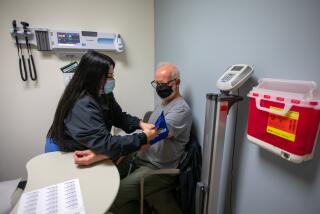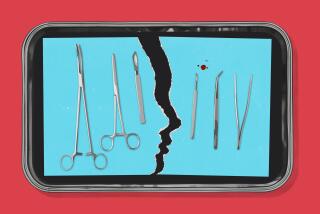Op-Ed: How doctor culture sinks U.S. healthcare

- Share via
Over the last pandemic year, we’ve seen doctors work heroically to save lives. Their dedication, expertise and work ethic represent the best of medical culture. But as we return to normality, we need to acknowledge that the same culture that turns doctors into heroes is also contributing to a healthcare crisis of rising costs and decaying standards.
Physicians, policy experts and academics all insist that American healthcare suffers from systemic issues. By “systemic,” they mean bureaucratic. Clinicians, they say, are bogged down by administrative burdens, pesky prior-authorization requirements and cumbersome computers that (literally) sit between doctors and patients.
I agree. Correcting these deficiencies will be vital for reform. But if these administrative fixes are the only healthcare changes we accomplish, then everyone will be sorely disappointed with the results.
In addition to fixing the system, we must also look closely at the values and norms that doctors acquire in medical school and carry throughout their careers. This invisible force — medical culture — wields tremendous influence over patients and physicians, with physical, financial and psychological consequences that range from lifesaving to life-ending.
COVID-19 made the physical harm of medical culture clear. Consider that nearly two-thirds of patients hospitalized with COVID-19 had at least one chronic disease, such as obesity, diabetes, hypertension and heart failure, according to National Institutes of Health research.
In critical care units, doctors pulled many of these patients back from the brink of death. But if American physicians had dedicated more time and effort toward preventing and better managing these types of chronic diseases, tens of thousands wouldn’t have needed hospitalization in the first place. And many of them would still be alive.
The field of scientific wellness aims to treat patients by using data based on their individual health, before disease emerges.
One obstacle is that insurers reimburse physicians too little for the time it takes to prevent disease. However, an equally large part of the problem is rooted in the priorities of physicians themselves. Preventing disease isn’t as visibly “heroic” as a lifesaving intervention. It’s undervalued, even in terms of compensation, although multiple studies show that when healthcare providers place a high value on primary care, they reduce chronic disease by half compared with national averages.
That medical bills can lead to financial ruin is no secret. According to a Gallup poll, half of U.S. patients worry that one major illness could force them to declare bankruptcy. We tend to blame the insurance and pharmaceutical industries for the high price of medical care. But we fail to recognize the role doctors play.
A review of articles published in the New England Journal of Medicine determined that one-third of “established medical practices … are found to be no better than a less expensive, simpler, or easier therapy or approach.” Another study estimated that 25% of all healthcare spending from 2012 to 2019 was wasted.
Physicians insist they put the needs of patients first. And yet it’s doctors who order unnecessary tests, overprescribe medications and perform risky surgeries when less-expensive approaches would be just as valuable. And when doctors benefit economically at the expense of patients, medical culture shields them from the shame of hypocrisy, assuring them that doing more is never wrong.
Finally, medical culture does psychological harm. In early 2020, a friend was diagnosed with ovarian cancer that rapidly spread to her liver, lung and brain. While delivering the news, her doctor added, “It’s not a death sentence.”
I have no idea why he would have said that. If he was implying a cure was possible, then he was more sadistic than compassionate. My friend deserved the truth. She died three days later.
Physicians are trained to offer hope, even when hope disguises an ugly truth. In 2014, a study of 70 Food and Drug Administration-approved chemotherapy agents found the cancer treatments extended life by an average of only 2.1 months. That time was often spent in a hospital, rather than at home or in palliative care. Hiding uncomfortable truths remains a cultural norm in medicine, one that benefits providers far more than patients.
How do we cure a culture that’s invisible yet highly influential? Begin at the beginning, with those who are educating and training our next generation of physicians.
To reduce the physical harm medical culture inflicts on patients, medical school deans must elevate the esteem of primary care, make clear its crucial role. To start, more internal medicine physicians should take the places of specialists in lecture halls.
Inflicting less financial harm on patients will mean lowering overall healthcare expenditures. In general, communities with more specialists have a higher frequency of procedures performed, greater healthcare costs but no improvement in quality or life expectancy. Again, the balance of specialists and primary care doctors is key. Leaders in academic medical centers can help, by increasing the ratio of primary care residents admitted to their programs.
Finally, much psychological damage could be avoided if physicians were trained to treat every patient like a family member. We would produce more compassionate physicians if residents and interns were asked, ”Did you treat all of your patients today as you would want if they were your parent, sibling or child?”
Many factors contribute to our nation’s soaring medical costs, flagging clinical quality and the rising dissatisfaction of both doctors and patients. The one problem we continually overlook with tragic consequences is the flawed culture of medicine.
Dr. Robert Pearl is a plastic and reconstructive surgeon and former chief executive of the Permanente Medical Group (Kaiser Permanente). He teaches at Stanford. His latest book is “Uncaring: How the Culture of Medicine Kills Doctors and Patients,” scheduled for publication in mid-May.
More to Read
A cure for the common opinion
Get thought-provoking perspectives with our weekly newsletter.
You may occasionally receive promotional content from the Los Angeles Times.











